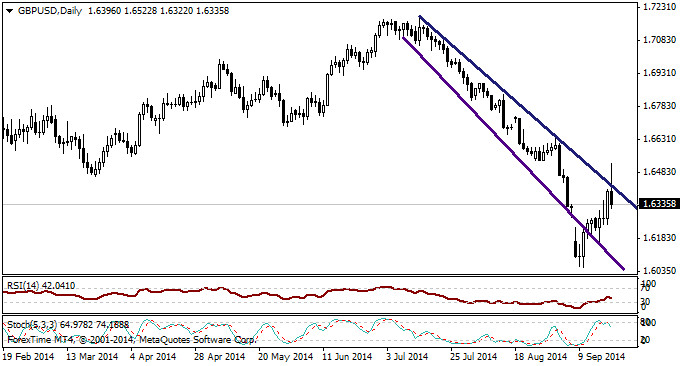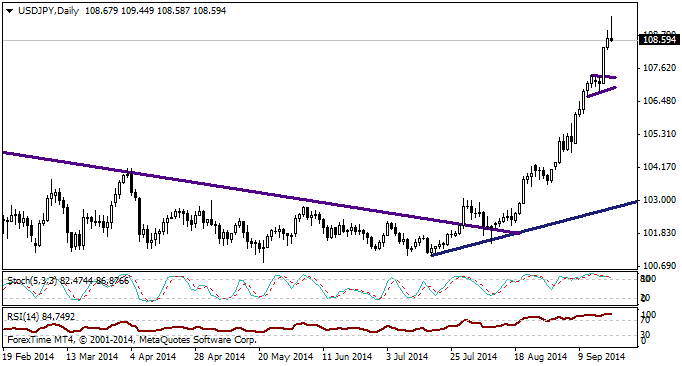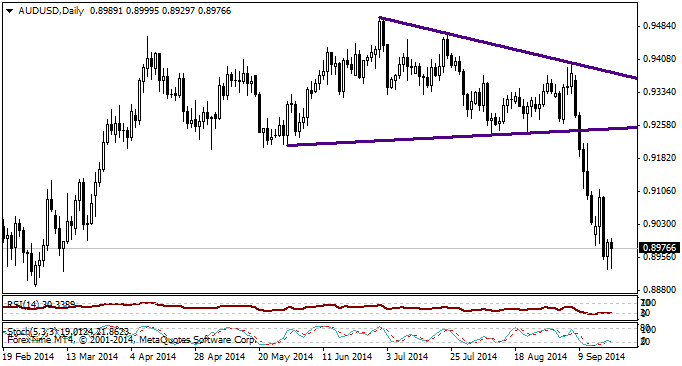EURUSD – A conclusion to the consolidation phase
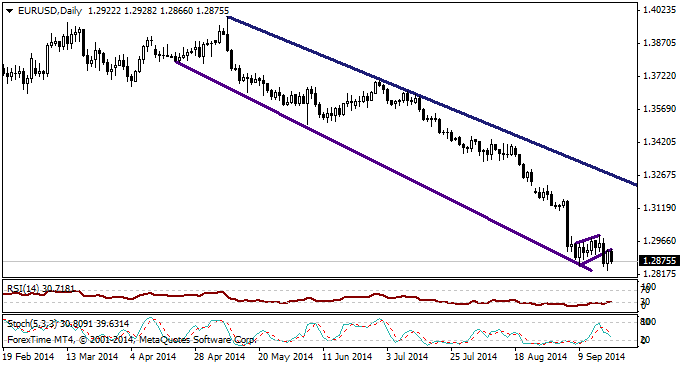
Economic data from the EU was low in quantity last week, but that doesn’t necessarily mean the European Union steered clear from economic headlines. In fact, it can be argued that the EU sentiment weakened further when it was suggested from the OECD that a slow recovery among nations using the Euro is holding back the global economy. Hopes that German economic data was returning to consistency were also dashed when the latest German ZEW Survey fell below expectations.
Despite this, the EURUSD continued to trade in a tight range and it wasn’t until the Federal Reserve announced on Wednesday evening that Quantitative Easing (QE) would conclude in October that the pair finally moved lower.
The upcoming week is packed with EU economic data. The latest EU and German PMIs are expected on Tuesday. On Wednesday, French employment figures will be followed by the latest German IFO expectations. On Thursday, Italian retail sales will come under the microscope and the week will conclude with the latest French and German business confidence indicators on Friday morning.
Moving onto the technicals on the Daily timeframe, although both the RSI and Stochastic Oscillator are located inside the oversold boundaries, this pair is unlikely to participate in a substantial upside rally anytime soon. The EU sentiment has remained low for some time, and the Federal Reserve announcing that QE is set to conclude next month is only going to reiterate to investors that the Fed are moving closer to normalizing monetary policy. As long as these fundamentals remain intact, the pair appears set to continue gradually declining through its bearish channel.
The current yearly low (1.2823) will be seen as support and potential support from here can be found at 1.2803 and 1.2775.
GBPUSD recovers losses as Scotland votes “NO”
As you would expect, all headlines originating from the United Kingdom were focused on Thursday’s Scottish referendum. In the end, “NO” prevailed but it wasn’t a walk in the park by any means. It was confirmed after polls concluded that over 4 million Scottish citizens participated in the referendum, with “NO” gaining around 55% of the votes. The GBP surged against its counterparts following the news, and reached as high as 1.6522 against the Dollar. This was roughly where the Cable was trading before “YES” votes began to be priced into the markets.
Economic news from the United Kingdom is light next week, with the fallout from the Scottish referendum perhaps going to continue in the media spotlight. However, it should be noted that in the midst of the Scotland drama, the Bank of England (BoE) disclosed its first rate hike will occur around spring 2015. It was also confirmed on Wednesday that two members of the Monetary Policy Committee (MPC) voted for a UK rate rise for the second successive month. A UK rate rise is edging closer to reality and moving forward, investor attraction to the GBP should return.
Looking at the technicals on the Daily timeframe, a clear fundamental vs technical battle could be set to take place. The pair is clearly being traded in a downward channel but due to the fundamentals listed just above, an economist would argue that the price is set to break out from the channel. However, a technical strategist would argue that due to the price only recently touching the upper trendline, the pair will now move lower within the channel. I will sit and watch this one from the side I think!
If the price breaks out of its channel, resistance can be found at 1.6457 and 1.6452. If the pair declines within the channel, support can be found at 1.6283 and 1.6201.
USDJPY continues to rally to the upside
In line with expectations, the USDJPY upside rally paused as the week commenced. As expected BoJ Governor, Kuroda repeated at the beginning of the week that although the BoJ are prepared to implement additional stimulus if necessary, there are no current plans to do so. This led to a small triangle pattern developing on the Daily timeframe.
However, this triangle pattern extended to the upside when the Federal Reserve confirmed on Wednesday evening that the Central Bank would conclude Quantitative Easing in October. Although the Fed continued refusing to offer any indications as to when it would raise rates, QE concluding is seen among investors as a clear signal that the Fed are stepping closer towards normalizing monetary policy. Buying pressure accelerated and the pair extended as high as 109.445, following the unexpected announcement from the Japanese government on Friday morning that it was cutting economic growth forecasts.
There are no scheduled major economic releases from Japan next week but now the Japanese government has downgraded economic growth expectations, investors are already pricing future BoJ stimulus. High risk economic releases from the United States include the latest US Manufacturing PMI (Tuesday), Durable Goods (Thursday) and finalized US 2Q GDP (Friday).
From a technical standpoint on a Daily timeframe, it’s quite clear to see that this pair is on a bull run. The current six year high, 109.449 will be seen as resistance and from this point, the next major resistance level is 110.660 (monthly timeframe).
Although the pair is clearly on a bull run, traders should be weary regarding any potential pullbacks. If a pullback does occur, support can be found at 108.350.
The Aussie continues to move to the downside
The Aussie continued to move substantially to the downside last week, but it wasn’t necessarily due to economic issues within the Australian economy.
As last week commenced, breaking news spread that the Australian Security Intelligence Organisation (ASIO) had raised Australia’s terror alert level to “high” and this was followed by a major police operation on Thursday evening that involved over 800 police officers. This flustered investors and as a result, the Aussie moved to the downside.
Although the Reserve Bank of Australia (RBA) had expressed in the past that its currency remained “overvalued” for months and Governor Stevens went as far to suggest that “investors were underestimating the chances of a significant drop in the AUD”, the RBA would have wanted this to come as a result of economic data, not due to a security issue. There are no major Australian economic releases scheduled for next week and I am expected some sort of consolidation/correction to take place.
The technicals on the Daily timeframe currently indicate that 0.8924 could be seen as a potential “double-bottom” for the pair. If the Aussie extends below this level, further support can be found at 0.8891.
However, both the RSI and Stochastic Oscillator are currently suggesting the pair is located within the oversold boundaries and if I am accurate in my assumption that the pair is in line for a consolidation/correction phase, 0.9030 and 0.9057 could be used as resistance levels.
Gold continues its gradual decline
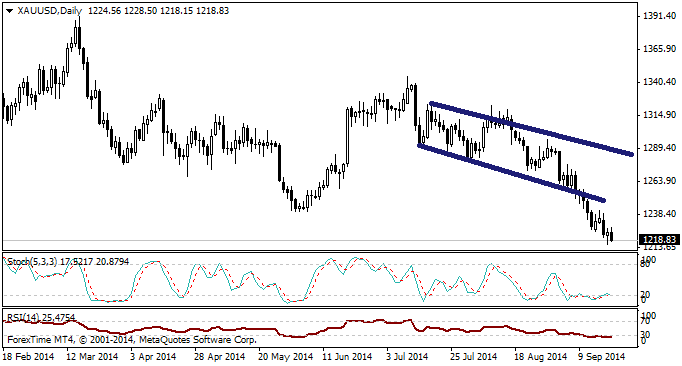
Gold continued its gradual decline to the downside last week and reached its lowest valuation since the beginning of 2014, following the Federal Reserve formally announcing that Quantitative Easing would conclude in October.
Despite the political uncertainty surrounding the Scottish referendum, the commodity barely moved in valuation which is surprising considering investors generally seek safe-havens in times of political uncertainty. This goes some way towards showing the lack of buyers in the Gold market at present.
Gold will likely move in accordance with how the markets react to the high risk United States economic data next week, so traders should keep an eye on the US Manufacturing PMI (Tuesday), Durable Goods (Thursday) and US 2Q GDP (Friday).
Saying that, an acknowledgement among stakeholders that the Federal Reserve are concluding QE next month will only reaffirm to investors that the Federal Reserve are moving closer to normalizing monetary policy. As long as US economic data remains consistent, Gold looks set to continue extending lower towards the December 2013 low, 1182.46 in the coming weeks.
There are no current technical patterns that stand out at present, but we can see that the commodity has declined by over $170 since February. Gold is clearly on a downtrend and will likely continue gradually declining lower with the Federal Reserve concluding QE next month. If Gold encounters an upturn in valuation, resistance can be found at 1224.50. Otherwise, support can be found at 1207 and 1196.
Recommended Content
Editors’ Picks
EUR/USD clings to gains above 1.0750 after US data

EUR/USD manages to hold in positive territory above 1.0750 despite retreating from the fresh multi-week high it set above 1.0800 earlier in the day. The US Dollar struggles to find demand following the weaker-than-expected NFP data.
GBP/USD declines below 1.2550 following NFP-inspired upsurge

GBP/USD struggles to preserve its bullish momentum and trades below 1.2550 in the American session. Earlier in the day, the disappointing April jobs report from the US triggered a USD selloff and allowed the pair to reach multi-week highs above 1.2600.
Gold struggles to hold above $2,300 despite falling US yields

Gold stays on the back foot below $2,300 in the American session on Friday. The benchmark 10-year US Treasury bond yield stays in negative territory below 4.6% after weak US data but the improving risk mood doesn't allow XAU/USD to gain traction.
Bitcoin Weekly Forecast: Should you buy BTC here? Premium

Bitcoin (BTC) price shows signs of a potential reversal but lacks confirmation, which has divided the investor community into two – those who are buying the dips and those who are expecting a further correction.
Week ahead – BoE and RBA decisions headline a calm week

Bank of England meets on Thursday, unlikely to signal rate cuts. Reserve Bank of Australia could maintain a higher-for-longer stance. Elsewhere, Bank of Japan releases summary of opinions.
